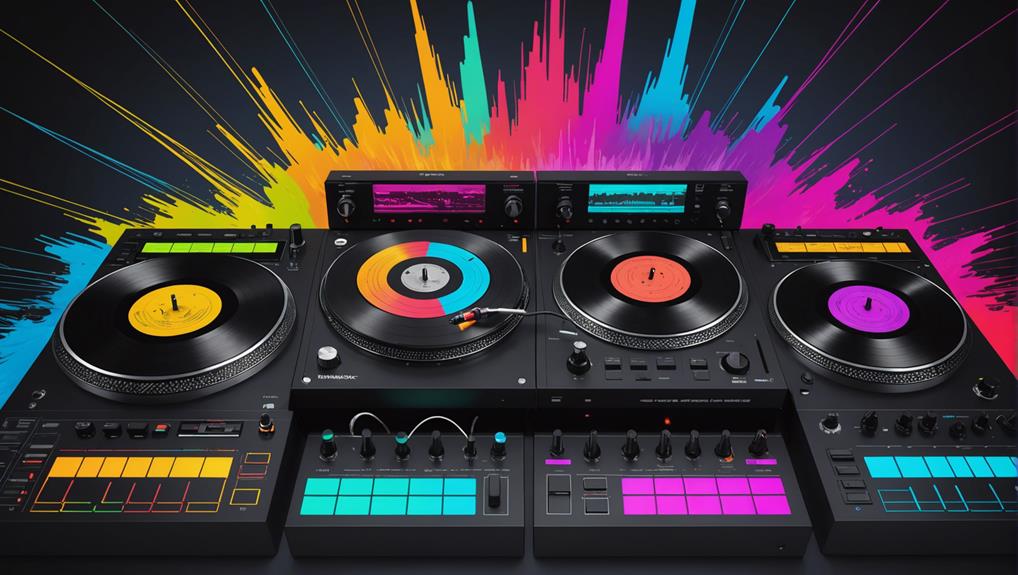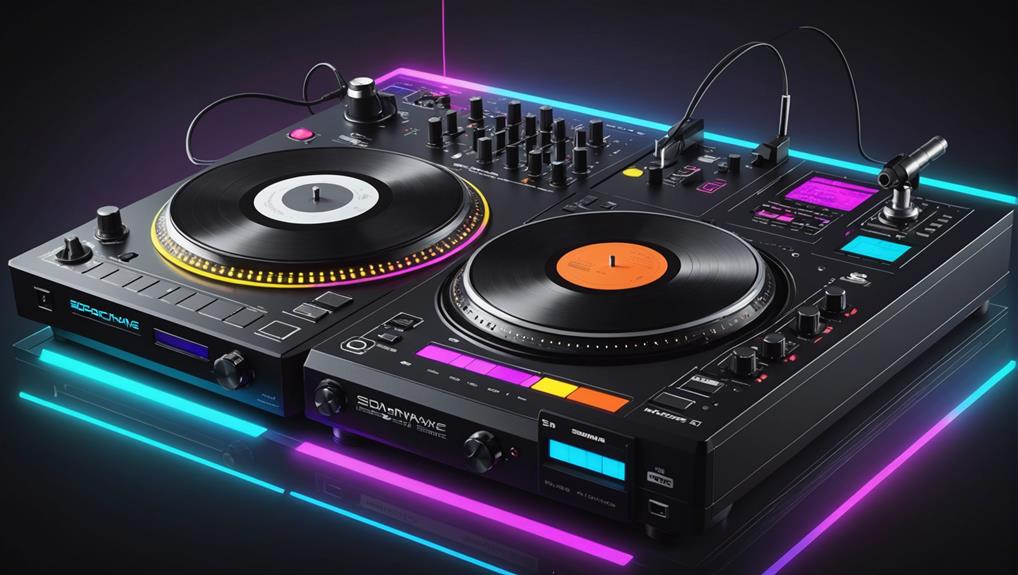No products in the cart.
You’ve likely heard of Kraftwerk, Aphex Twin, and Jean Michel Jarre, three titans who fundamentally shaped electronic dance music. Kraftwerk transformed the landscape with their synthesizers and drum machines, crafting the blueprint for modern EDM with their methodical sound designs in albums like *Trans-Europe Express*. Aphex Twin, or Richard D. James, enhanced the genre further with his intricate, evolutionary soundscapes that challenge traditional auditory experiences. Jean Michel Jarre complemented his music with awe-inspiring visuals, turning concerts into expansive sensory events. Each artist brought a unique element that pushed the boundaries of what you might think possible in music, offering new horizons to explore in their groundbreaking works.
Contents
hide
Key Takeaways
- Kraftwerk pioneered the use of synthesizers and drum machines, shaping electronic music’s foundation.
- Aphex Twin, known as Richard D. James, revolutionized EDM with complex, evolving soundscapes.
- Jean Michel Jarre combined technology and visuals to create immersive concert experiences.
- All three artists influenced subsequent generations through innovative sound and visual design.
- Their contributions have been instrumental in defining and expanding the genre of electronic dance music.
Kraftwerk’s Revolutionary Influence
Kraftwerk fundamentally transformed electronic music, pioneering the use of synthesizers, drum machines, and innovative production techniques that laid the groundwork for modern electronic dance music. As you explore their world, you’ll see how Kraftwerk‘s iconic aesthetics and their methodical approach to sound design became instrumental in the electronic music evolution. Albums like *Trans-Europe Express* and *The Man Machine* not only showcase their musical ingenuity but also a visual and sonic identity that many later artists tried to emulate.
Their meticulous use of electronic instruments created a blueprint that defined the genre’s future. Imagine the landscape of today’s electronic scenes without Kraftwerk’s revolutionary impact—it’s nearly impossible. Their sounds weren’t just music; they were complex audio sculptures tailored to resonate well beyond the dance floors. The German ensemble didn’t just play notes; they engineered an auditory experience that encapsulated the feel of modernity and the pulse of technology.
This pioneering group didn’t just make tracks; they crafted the very essence of what we now celebrate as electronic dance music. As you investigate their discography, you’ll uncover the roots of a genre that continues to morph and resonate with new generations.
Aphex Twin’s Innovative Soundscapes
Aphex Twin, the brainchild of Richard D. James, revolutionized electronic music with his complex and cutting-edge soundscapes. You’ve probably heard how he intertwines techno, ambient, and experimental sounds, but it’s the way he guarantees evolutionary synthesis techniques that sets him apart. His tracks aren’t just songs; they’re auditory ecosystems, evolving and unfolding with intricate precision. Each composition showcases his knack for blending unexpected sounds into cohesive, immersive experiences.
His influence doesn’t stop at your ears. Aphex Twin‘s immersive live performances are transformative events that redefine the concert experience. Imagine standing in a crowd, feeling the pulse of bass resonate through your body as lights sync to a rhythm that seems to warp time itself. This isn’t just a show; it’s a sensory journey curated by a master.
Richard D. James, as Aphex Twin, doesn’t just make music. He crafts environments, inviting you to step into a world where soundscapes shift subtly and dramatically. His meticulous attention to detail guarantees that every beat, every synth line, every drop is perfectly placed, cementing his legacy as a pivotal figure in electronic dance music history.
Jean Michel Jarre’s Visual Spectacles
Jean Michel Jarre’s live performances transcend traditional concerts, blending cutting-edge technology with stunning visuals to create unforgettable sensory experiences. His concerts showcase not just his musical prowess but a masterclass in visual storytelling and technological wizardry. Each performance is a canvas where lights, lasers, and pyrotechnics paint a vivid tableau, synchronized perfectly with his electronic soundscapes.
This spectacular stagecraft was epitomized at the 1979 ‘Rendez-Vous Houston‘, a concert that drew over 1.3 million attendees and set a new benchmark for electronic music events. Here, Jarre transformed a cityscape into a living, breathing entity of sound and light, demonstrating his unique ability to fuse architecture with performance art.
The iconic ‘Oxygène’ album cover further mirrors his vision of integrating futuristic visuals with music, offering a glimpse into the immersive experiences he crafts at his shows. Through these elements, Jarre doesn’t just perform; he envelops you in an environment where every beat and light pulse catapults you into a narrative of futuristic fantasy.
In essence, Jarre’s performances are more than concerts; they’re grand explorations of what it means to experience music visually and sonically, making him a true pioneer in the domain of electronic music performance art.
Frequently Asked Questions
Who Pioneered Electronic Dance Music?
You’re exploring who pioneered electronic dance music? Look at Kraftwerk’s genre origins, Giorgio Moroder’s influential tracks, and Frankie Knuckles’ role in house music, each pivotal in shaping the landscape of this vibrant musical genre.
Who Is the Godfather of EDM Music?
Giorgio Moroder, often hailed as the Godfather of EDM, fundamentally transformed the genre through his innovative fusion of electronic sounds and disco rhythms, greatly influencing the music landscape. His work continues to inspire.
Who Is the Grandfather of Electronic Dance Music?
You’re exploring who shaped the electronic dance music scene. Giorgio Moroder, dubbed the ‘Grandfather of EDM,’ profoundly influenced genre evolution with innovative uses of the Moog synthesizer, revolutionizing the industry’s sound and development.
Who Revolutionized Edm?
You’d find that Kraftwerk revolutionized EDM, fundamentally shifting genre evolution and impacting festival experiences worldwide. Their innovative use of electronic sounds and visuals set the stage for modern electronic music landscapes.
Conclusion
You’ve explored the vanguards of electronic dance music, each transformative in their own right. Kraftwerk engineered the blueprint for electronic rhythms that echo through today’s genres.
Aphex Twin, meanwhile, sculpted soundscapes that pushed the boundaries of electronic music’s complexity and depth.
Jean Michel Jarre’s concerts turned music into engulfing visual art, pioneering a synthesis of sound and spectacle.
Their collective legacies aren’t just about sound; they crafted experiences that redefine the sensory possibilities of music.




